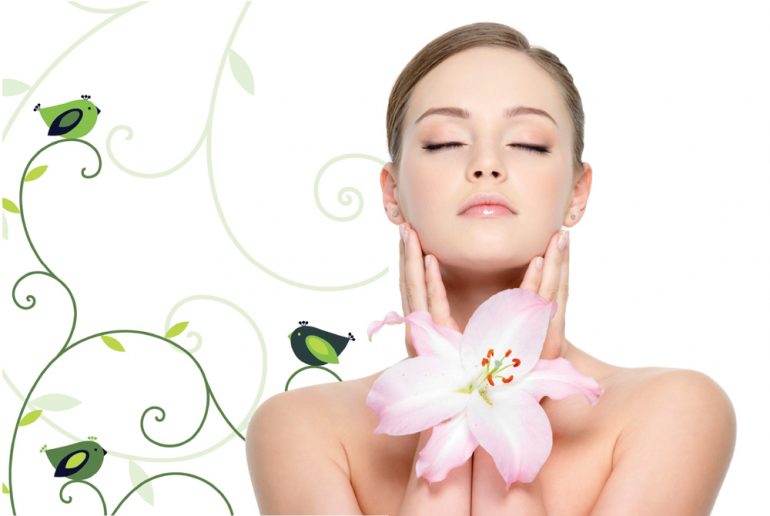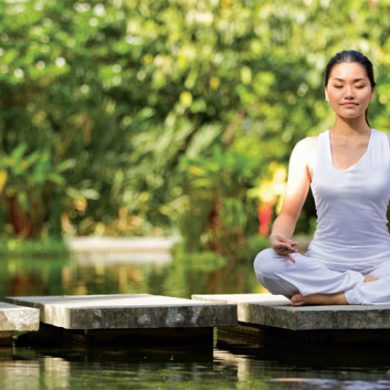Clear, glowing skin and shiny hair are some of the hallmarks of beauty. Although it shows on the outside, beauty comes from within. When we are happy, we smile, and it is beautiful. We might be wearing designer clothes, but our best accessory is always our smile. There is a certain calm and confidence that we carry with us when we know who we are. All of this comes from following an enlightened lifestyle. Our health also plays a huge role in how beautiful we feel. Make- up only goes so far in helping to improve our appearance. When we are in optimum health our skin looks and feels good even without make-up. Some of the best beauty secrets come from Ayurveda.
Skin care
Our skin covers our body, and connects us to our environment. The skin is where we feel the sense of touch, and where we experience pain, temperature changes, and pressure. We know that when we eat food, we need to take care to eat fresh foods, and to avoid preservatives and chemicals. The lotions and products that we apply to the skin are basically ingested by the skin in much the same way. yes, the skin “eats” what we feed it. so we need to be careful to use natural products. The basic rule of thumb in ayurveda is “if you can’t eat it, do not put it on your skin!”
Think about it: would you eat cetyl alcohol, sodium lauryl sulfate, or red dye #17? These are very common ingredients in many popular brand-name moisturizers and soaps. We have to read the labels on our beauty products the same way we read the labels on the foods we eat. There are many synthetic and petrochemical ingredients in personal care products. Pick up any bottle of lotion, shampoo, or toothpaste in your home now and you can see which natural ingredients they contain, and how much they contain. according to the FDA’s personal care products packaging standards, the further the name of an ingredient is down the list on a label, the less of that ingredient the product contains.
You’ll find mineral oil in commercial lotions, creams and baby care products quite often. Mineral oil is clear, liquid oil with no scent and it does not spoil. it is produced as a byproduct of the distillation of gasoline from crude oil. Mineral oil is leftover liquid, and because there is so much of it, it is very inexpensive. it actually costs more money to dispose of mineral oil, than to buy it.
The skin is the body’s largest organ and plays an important role in maintaining overall health. However, mineral oil is foreign to the human body. Mineral oil acts as a thin layer on the skin. it is difficult to absorb and clogs the pores, which slows the skin’s ability to eliminate toxins. after the oil is eventually absorbed, it is broken down by the liver and passes through the intestinal tract, where it absorbs the fat-soluble vitamins found there. Mineral oil steals important vitamins from the body, vitamins that the body will not be able to replace. This can eventually lead to nutritional deficiencies. The medical community has said that mineral oil should never be taken orally or used as an ingredient in medications. so, remember the rule: “if you can’t eat it, do not put it on your skin!” fortunately, we have many alternatives to mineral oil.
Skin is alive, and the best way to give life back to the skin is to use natural products. Plant-based products, meaning flowers, vegetables, fruits, and herbs are nourishing and beneficial to the skin. Vegetable oils are extracts from plants. The best oils are organic, which means that the plants they are made from have not been sprayed or fertilized with chemicals. There are many beauty products that are made with these natural ingredients and you can often find them in health food stores.
Vata skin tends to be dry and rough. Because it is thinner than other skin, it may show its age more quickly. Vata skin is cool to the touch. When you shake hands with a Vata person you notice this right away! Vata skin gets dehydrated easily, so it needs lots of moisture to stay in balance.
Abhyanga, warm oil self-massage is great for all the doshas (body types), and it is especially beneficial for Vata types. it helps to keep the skin lubricated, and it helps the skin to release toxins. abhyanga also helps to tone the muscles and soothe the nervous system. The massage can be done in the morning before your shower, or in the evening before bed. start by warming the oil to skin temperature, and drizzle a small amount of oil into the palms of your hands. Massage the top of your scalp (on days when you wash your hair), paying particular attention to the circumference of your ears, and the soles of your feet. Massage with long strokes on your limbs, and round strokes on your joints. it’s best to leave the oil on the body for 20 minutes before washing it off in a warm shower or bath.
Pitta skin is sensitive. People with Pitta skin often have fair skin and freckles. Pitta is made up of fire and water, so as you can imagine, there is a lot of heat in this dosha. Pittas run warm, and when you hold their hands, you will feel it!
They are prone to redness, rashes, and rosacea. To balance the heat, Pittas need cooling treatments for their skin. rose water is cooling and soothing to Pitta skin. Keep a spray handy to use whenever you feel the heat rising. Definitely stay out of the sun when you can, and use sun protection on your skin at all times.

Summer time is Pitta season, and this is a time when we all need to be a little more mindful about our skin care in the sun. ayurveda has these tips for us:
- Avoid exposure to the sun when angry, hungry or upset. These factors increase Pitta, which makes the skin more susceptible to sun damage.
- Protect yourself with sunscreen; and also with clothing, hats, long sleeves, and sunglasses during times when you are most sensitive.
- Avoid the mid-day sun. early morning sun is gentler to the skin.
- Cool yourself from the inside by eating cool foods, salads, fresh sweet pears, and raisins. avoid hot foods like peppers and chilies.
- Cool down skin with a mask made of watermelon puree. avoid the eye area, and rinse off with lukewarm water after about 15 minutes.
Kapha skin is thick and soft, and tends to be oily. Because Kapha skin is naturally moist, it tends to age more slowly. Kaphas can have large pores, especially int the T-Zone of the face. Kaphas need to exfoliate to help skin release built-up ama, or toxins. An herbal clay mask is ideal for this!
Acne

Acne is a common skin disease that affects more than 85 percent of the population at some point in their lives. acne is more common in men than women during adolescence; and more common in women than men during adulthood. ayurveda says that acne is an imbalance of all the three doshas: Vata, Pitta and Kapha, with the main cause being the aggravation of the pitta dosha. Pitta is made up of a combination of fire and water, hence the heat, or redness of the skin. Since a Pitta dosha imbalance is deep in the physiology, creams and tropical treatments just mask the symptoms of acne. Ayurveda recommends a pitta diet and lifestyle routine to tackle the disease at the root cause. Meditation and yoga help to ease stress, which is a contributing factor. When experiencing a breakout of acne, try making a paste of the turmeric powder and water and applying to the blemishes with a cotton ball. Turmeric is an antibiotic and antibacterial, so will help calm the eruptions.
 Lissa Coffey is a lifestyle and relationship expert who serves up an inspiring blend of ancient wisdom and modern style. She appears frequently on television and radio, and contributes to national publications with her insightful and compassionate approach to modern-day issues. Coffey is also a bestselling author and has written books like “Song Divine: A New Lyrical Rendition of the Bhagavad Gita.” www.WhatsYourDosha.com.
Lissa Coffey is a lifestyle and relationship expert who serves up an inspiring blend of ancient wisdom and modern style. She appears frequently on television and radio, and contributes to national publications with her insightful and compassionate approach to modern-day issues. Coffey is also a bestselling author and has written books like “Song Divine: A New Lyrical Rendition of the Bhagavad Gita.” www.WhatsYourDosha.com.







